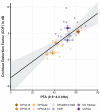Genetic Hearing Loss Affects Cochlear Processing
- PMID: 36360160
- PMCID: PMC9690229
- DOI: 10.3390/genes13111923
Genetic Hearing Loss Affects Cochlear Processing
Abstract
The relationship between speech recognition and hereditary hearing loss is not straightforward. Underlying genetic defects might determine an impaired cochlear processing of sound. We obtained data from nine groups of patients with a specific type of genetic hearing loss. For each group, the affected cochlear site-of-lesion was determined based on previously published animal studies. Retrospectively obtained speech recognition scores in noise were related to several aspects of supra-threshold cochlear processing as assessed by psychophysical measurements. The differences in speech perception in noise between these patient groups could be explained by these factors and partially by the hypothesized affected structure of the cochlea, suggesting that speech recognition in noise was associated with a genetics-related malfunctioning of the cochlea. In particular, regression models indicate that loudness growth and spectral resolution best describe the cochlear distortions and are thus a good biomarker for speech understanding in noise.
Keywords: frequency discrimination; gap detection; hereditary hearing loss; loudness growth; otogenetics; speech-in-noise.
Conflict of interest statement
The authors declare no conflict of interest.
Figures



References
-
- Vermeire K., Knoop A., Boel C., Auwers S., Schenus L., Talaveron-Rodriguez M., De Boom C., De Sloovere M. Speech Recognition in Noise by Younger and Older Adults: Effects of Age, Hearing Loss, and Temporal Resolution. Ann. Otol. Rhinol. Laryngol. 2015;125:297–302. doi: 10.1177/0003489415611424. - DOI - PubMed
MeSH terms
LinkOut - more resources
Full Text Sources
Medical
Miscellaneous

